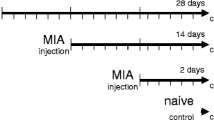Abstract
The chondrocytes of cartilage have so far been reported to include three mechanoresponsive genes: cartilage matrix protein (CMP, matrilin-1), type X collagen, and Indian hedgehog (Ihh). In fact, all of the genes identified in these chondrocytes are associated solely with mechanical stress. In this study we examined the how mechanical stress influenced the patterns of gene expression of chondrocytes in three-dimensional (3D) sponges in order to better understand the mechanisms that control the chondrocyte phenotype during the development of osteoarthritis. We cultured mouse chondrocytes in 3D sponge as a model of mechanical stress and isolated total RNA for a large-scale DNA microarray analysis covering 12000 genes. We analyzed the pattern of gene expression in relation to gene localization in cellular components such as the cytoplasm, cytoskeleton, and nucleus. Immunoblotting of osteoarthritis cartilage were performed using polyclonal anti-clock antibody. The biological rhythm of mRNA of clock and clock-related genes was analyzed by real-time polymerase chain reaction (PCR). Clock gene was confirmed by real-time PCR to validate the microarray data. Other clock-related genes such as Per1 and Per2 were also expressed in chondrocytes, exhibiting biological rhythm after serum shock. The large-scale DNA microarray indicated that clock and other genes functionally associated with mechanical stress play an essential role in regulating the biological rhythm of chondrocyte metabolism in osteoarthritis cartilage.
Similar content being viewed by others
References
JF Gillooly AP Allen GB West JH Brown (2005) ArticleTitleThe rate of DNA evolution: effects of body size and temperature on the molecular clock Proc Natl Acad Sci USA 102 140–5 10.1073/pnas.0407735101 Occurrence Handle10.1073/pnas.0407735101 Occurrence Handle1:CAS:528:DC%2BD2MXmtlehug%3D%3D Occurrence Handle15618408
E Nagoshi C Saini C Bauer T Laroche F Naef U Schibler (2004) ArticleTitleCircadian gene expression in individual fibroblasts: cell-autonomous and self-sustained oscillators pass time to daughter cells Cell 119 693–705 Occurrence Handle1:CAS:528:DC%2BD2cXhtVGls7fL Occurrence Handle15550250 Occurrence Handle10.1016/j.cell.2004.11.015
Q Wu Y Zhang Q Chen (2001) ArticleTitleIndian hedgehog is an essential component of mechanotransduction complex to stimulate chondrocyte proliferation J Biol Chem 276 35290–6 10.1074/jbc.M101055200 Occurrence Handle10.1074/jbc.M101055200 Occurrence Handle1:CAS:528:DC%2BD3MXntFaiurw%3D Occurrence Handle11466306
Balsalobre A, Damiola F, Schibler U. A serum shock induces circadian gene expression in mammalian tissue culture cells. Cell 1998;929–37
JH Kellgren JS Lawrence (1957) ArticleTitleRadiological assessment of osteoarthritis Ann Rheum Dis 16 494–501 Occurrence Handle10.1136/ard.16.4.494 Occurrence Handle1:STN:280:DyaG1c%2FktFeltQ%3D%3D Occurrence Handle13498604
L Fu MS Patel A Bradley EF Wagner G Karsenty (2005) ArticleTitleThe molecular clock mediates leptin-regulated bone formation Cell 122 803–15 10.1016/j.cell.2005.06.028 Occurrence Handle10.1016/j.cell.2005.06.028 Occurrence Handle1:CAS:528:DC%2BD2MXhtVaqu7rM Occurrence Handle16143109
SJ Millward-Sadler MO Wright LW Davies G Nuki DM Salter (2000) ArticleTitleMechanotransduction via integrins and interleukin-4 results in altered aggrecan and matrix metalloprotease 3 gene expression in normal, but osteoarthritic, human articular chondrocytes Arthritis Rheum 43 2091–9 10.1002/1529-0131(200009)43:9<2091::AID-ANR21>3.0.CO;2-C Occurrence Handle10.1002/1529-0131(200009)43:9<2091::AID-ANR21>3.0.CO;2-C Occurrence Handle1:CAS:528:DC%2BD3cXnt1KnsLg%3D Occurrence Handle11014361
RK Sironen HM Karjalainen MA Elo K Kaarniranta K Torronen M Takigawa et al. (2002) ArticleTitlecDNA array reveals mechanosensitive genes in chondrocytic cells under hydrostatic pressure Biochim Biophys Acta 19 45–54
S Mizuno T Tateishi T Ushida J Glowacki (2002) ArticleTitleHydrostatic fluid pressure enhances matrix synthesis and accumulation by bovine chondrocytes in three-dimensional culture J Cell Physiol 193 319–27 10.1002/jcp.10180 Occurrence Handle10.1002/jcp.10180 Occurrence Handle1:CAS:528:DC%2BD38XovVaksbo%3D Occurrence Handle12384984
DD D’Lima S Hashimoto PC Chen CW Colwell SuffixJr MK Lotz (2001) ArticleTitleHuman chondrocyte apoptosis in response to mechanical injury Osteoarthritis Cartilage 9 712–9 10.1053/joca.2001.0468 Occurrence Handle10.1053/joca.2001.0468 Occurrence Handle11795990
N Ohashi AG Robling DB Burr CH Turner (2002) ArticleTitleThe effects of dynamic axial loading on the rat growth plate J Bone Miner Res 17 284–92 10.1359/jbmr.2002.17.2.284 Occurrence Handle10.1359/jbmr.2002.17.2.284 Occurrence Handle11811559
M Siczkowski FM Watt (1990) ArticleTitleSubpopulations of chondrocytes from different zones of pig articular cartilage: isolation, growth and proteoglycan synthesis in culture J Cell Sci 2 349–60
GH Korver RJ van de Stadt GP Van Kampen JK Van der Korst (1990) ArticleTitleComposition of proteoglycans synthesized in different layers of cultured anatomically intact articular cartilage Matrix 6 394–401
HJ Haüselman J Flechtenmcher L Michal EJ-MA Thonar M Shinmei KE Kuettner et al. (1996) ArticleTitleThe superficial layer of human articular cartilage is more susceptible to interleukin-1-induced damage than the deeper layers Arthritis Rheum 39 478–88 Occurrence Handle10.1002/art.1780390316
R Cancedda FD Catagnola P Catagnola (1995) ArticleTitleChondrocyte differentiation Int Rev Cytol 159 265–358 10.1016/S0074-7696(08)62109-9 Occurrence Handle10.1016/S0074-7696(08)62109-9 Occurrence Handle1:STN:280:DyaK2M3lsF2rsA%3D%3D Occurrence Handle7737795
T Aigner W Bertling H Stoss G Weseloh K von der Mark (1993) ArticleTitleIndependent expression of fibril-forming collagens I, II, and III in chondrocytes of human osteoarthritic cartilage J Clin Invest 91 829–37 10.1172/JCI116303 Occurrence Handle10.1172/JCI116303 Occurrence Handle1:CAS:528:DyaK3sXitFSks70%3D Occurrence Handle7680669
G Cs-Szabó PJ Roughley AHK Plaas TT Glant (1995) ArticleTitleLarge and small proteoglycans of osteoarthritic and rheumatoid articular cartilage Arthritis Rheum 38 660–8 Occurrence Handle10.1002/art.1780380514 Occurrence Handle7538297
RD Young PA Lawrence VC Duance T Aigner P Monaghan (2000) ArticleTitleImmunolocalization of collagen type II and III in single fibrils of human articular cartilage J Histochem Cytochem 48 423–32 Occurrence Handle1:CAS:528:DC%2BD3cXhslSmu78%3D Occurrence Handle10681396
AG Nerlich I Wiest K von der Mark (1993) ArticleTitleImmunohistochemical analysis of interstitial collagens in cartilage of different stages of osteoarthrosis Virchows Arch B Cell Pathol Incl Mol Pathol 63 249–55 10.1007/BF02899269 Occurrence Handle10.1007/BF02899269 Occurrence Handle1:STN:280:DyaK3s3ot1WitA%3D%3D Occurrence Handle8099462
Author information
Authors and Affiliations
Corresponding author
About this article
Cite this article
Kanbe, K., Inoue, K., Xiang, C. et al. Identification of clock as a mechanosensitive gene by large-scale DNA microarray analysis: downregulation in osteoarthritic cartilage. Mod Rheumatol 16, 131–136 (2006). https://doi.org/10.1007/s10165-006-0469-3
Received:
Accepted:
Issue Date:
DOI: https://doi.org/10.1007/s10165-006-0469-3




